1 INTRODUCTION
Following its discovery (Appleton 1932; Marconi 1967), the ionosphere is observed and monitored by numerous instruments including various radio sounders such as ionosondes, ground based receivers of global navigation satellite system (GNSS) and satellite-based radio occultation experiments, and other devices (e.g., Kim et al. 2011; Choi et al. 2013; Park et al. 2015; Hong et al. 2017). Among these, ionosondes have been used world-wide for a long time as vertical sounding radars with sweeping frequencies. Ionosondes are considered as one of the most common tools for monitoring the ionosphere, and ionosonde stations are networked by international organizations (Galkin et al. 2006).
An ionosonde typically produces an ionogram that displays radio echoes in the frequency-range plane. The trajectory of radio echoes is projected on an ionogram, and this is either manually or automatically scaled to extract the parameters of the ionosphere such as foF2 (peak frequency of the F2 layer), hmF2 (peak height of the F2 layer), and other parameters.
With respect to automatically scaling ionograms that involves automatic extraction of ionospheric parameters via software, several software programs have been developed since 1960s. A widely used program is automatic realtime ionogram scaler with true height (ARTIST), which was developed by the University of Massachusetts, Lowell, USA. This is continuously updated (Reinisch & Huang 1983; Gilbert & Smith 1988; Galkin et al. 1996; Reinisch et al. 2005; Galkin et al. 2008). Another widely used program is Autoscala that was recorded in the advanced ionospheric sounderistituto nazionale di geofisica vulcanologia (AIS-INGV) and developed by istituto nazionale di geofisica vulcanologia (INGV). Other programs are used and are in the process of development or upgrading.
Despite the advances in the aforementioned scaling programs, automatic scaling occasionally yields unreasonable results that misrepresent the ionosphere. Specifically, Gilbert & Smith (1988) argued that when the ARTIST software is used to extract the ionospheric parameters, an average of 7 % of the results are not reliable. More recently, Bamford et al. (2008) compared the eight ionospheric parameters obtained from automatic and manual scaling as follows: foE (E layer critical frequency), foF2, foF1 (F1 layer critical frequency), fmin (minimum frequency of ionogram echoes), MUF(3000) F2 (maximum usable frequency for ground distance of 3,000 km in F2 region), M(3000)F2 (=MUF(3000)/foF2), h’E (minimum virtual height of E trace), and h’F2 (Minimum virtual height of F2 trace). The results indicated that an average of 10 % of foF2, h’E, MUF(3,000), and M(3000) F2 and 20 % of the remaining parameters are not reliable. The percentage of erroneous results appears to vary with software versions and ionosonde stations.
Therefore, it is necessary to verify or evaluate the quality of the ionosonde data acquired from Jeju station, which was recently established with an auto-scaling program, ARTIST 5002. Section 2 explains the data used and how automatic and manual scaling procedures are executed. A comparison of the ionospheric parameters obtained by the two methods is given in Section 3, and finally conclusions are detailed in Section 4.
2 DATA AND METHOD
The data used in the study corresponds to ionograms measured by Jeju ionosonde (33.43˚N, 126.30˚E) and autoscaled ionospheric parameters that were provided by the Korea Space Weather Center (KSWC) of National Research Agency (NRA). Jeju ionosonde produces ionograms every 15 min, and we analyzed the ionograms that were produced throughout 2012.
The ionograms are automatically scaled to acquire ionospheric parameters such as foF2 (peak frequency of the F2 layer) and hmF2 (peak height of the F2 layer). Jeju ionograms are routinely scaled by an auto-scaling software termed as the Automatic Real-Time Ionogram Scaler with True Height (ARTIST) 5002 program developed by Lowell University. The program is built into the Standard Archiving Output (SAO) explorer, and this allows users to visualize and edit ionograms. The ionospheric parameters are computed by the auto-scaling program when an ionogram is fed into the SAO explorer. Fig. 1 shows an example of a normal ionogram that results in auto-scaled parameters that are perfectly matched with manually scaled values. The autoscaled parameters are stored in the form of an SAO file.
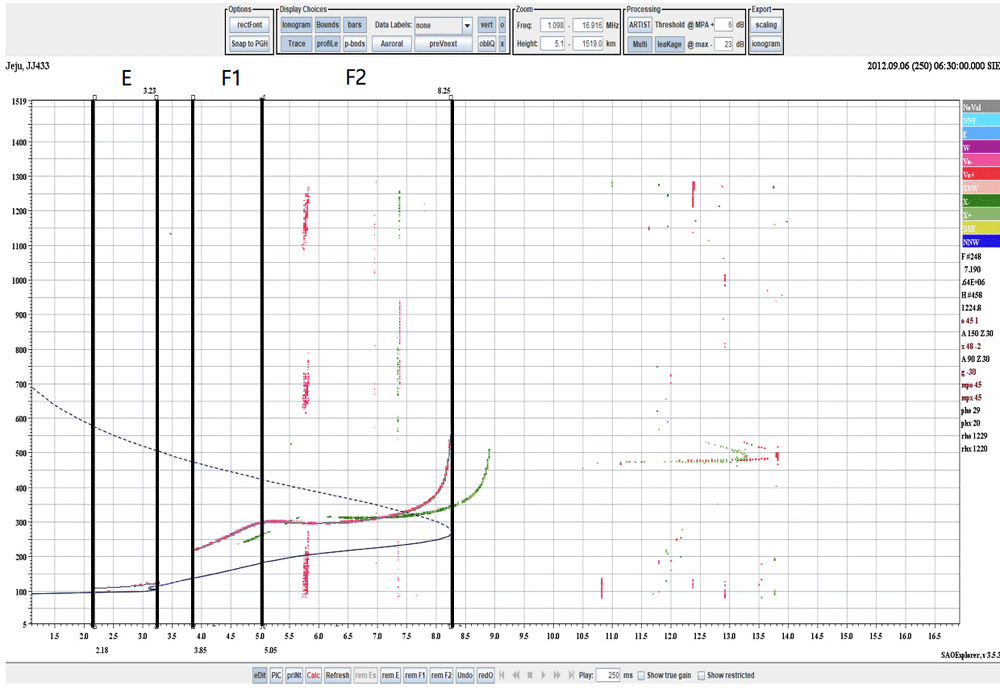
When noisy or disturbed ionograms are fed into the autoscaling program, the resulting parameters are unreasonable or occasionally significantly incorrect (Reinisch & Huang 1983). We independently trained ourselves through 160 examples of the ionograms via the standard method described in the handbook detailed by Wakai et al. (1987), and we manually scaled all the 35,136 ionograms measured in 2012. The handbook shows ionograms in specific conditions, such as spread F and sporadic E, and explains how to extract ionospheric parameters. It is used by numerous researchers in the field (e.g., Pezzopane & Scotto 2010). In the manual scaling process, there are five cases in which the auto-scaling program yields incorrect results when compared with manually scaled values. A brief description of the five cases is provided in Table 1. Figs. 2–6 show the aforementioned five cases as follows: left figures include a curve that represents the ionospheric profile and vertical lines that denote foF2, fminF(the minimum frequency of F layer), and F1/F2 peaks derived by the autoscaling program, and right figures contain the corresponding curve and lines from manual scaling. Figure 2 illustrates the first case in which foF2 is incorrectly determined. In the left plot in Fig. 2, the end point of the O-mode trace (red dots) should correspond to the foF2 value although the midpoint of the trace is mistakenly selected as the foF2 value. Fig. 3 shows the second case in which the tracing of echoes is not properly fitted. In the right plot of Fig. 3, the O-mode trace is properly fitted, thereby resulting in a well-fitted profile with accurate foF2 and F2 peaks. The third case corresponds to when the fminF is misrecognized as shown in Fig. 4. In the left plot of Fig. 4, the minimum frequency of F-layer echoes is set incorrectly due to the sporadic E (Es) layer echoes. The fourth case corresponds to when the F1 layer and the F2 layer are not correctly distinguished (Fig. 5). In a normal O-mode trace, a cusp is observed at the critical frequency of F1 layer and F2 layer. However, the ARTIST program does not recognize the cusp, and thus that it fails to distinguish the F1 layer from the F2 layer. Conversely, this is correctly performed by manual scaling as shown in the right plot of Fig. 5. The final case corresponds to when the two and more of the aforementioned cases occur simultaneously.
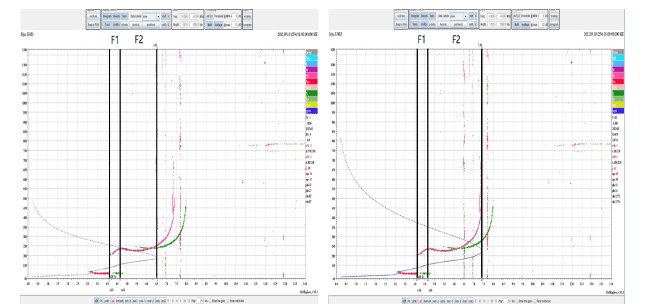
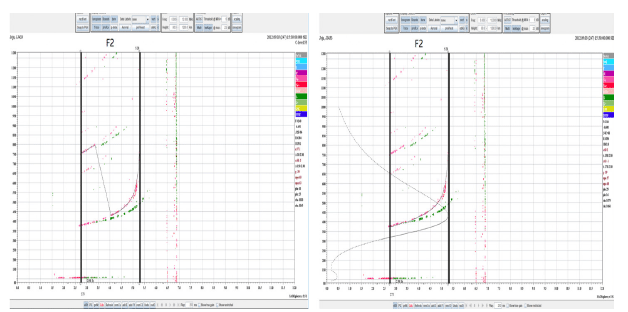
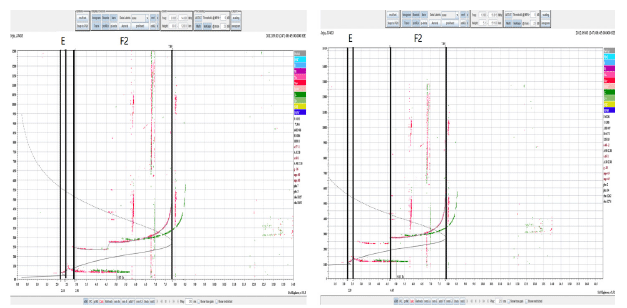
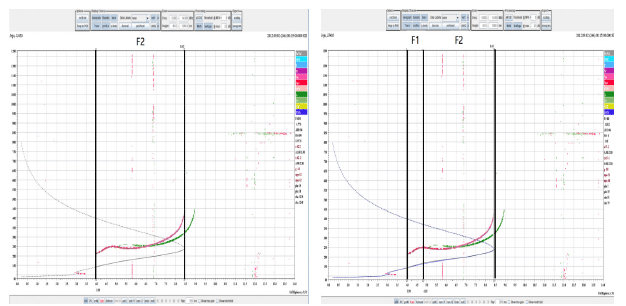
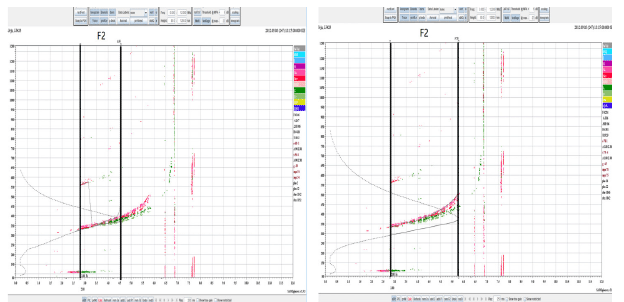
Fig. 6 shows an example of this case in which incorrect determination of the foF2 (case 1) and incorrect tracing of the profile (case 2) occur simultaneously.
3 RESULTS
Among the parameters of the ionosphere, we compared manually scaled foF2 and hmF2 values (the peak height of F2 layer) with the corresponding auto-scaled values. Fig. 7 shows differences in foF2 and hmF2 between auto-scaled and manually scaled values in the form of contours on the time versus day of year plane. When a contour is closer to blue, then the auto-scaled values are higher. Conversely, when a contour is closer to red, then the manually scaled values are higher. Fig. 7 illustrates that hmF2 differences are more evident when compared with F2 differences.
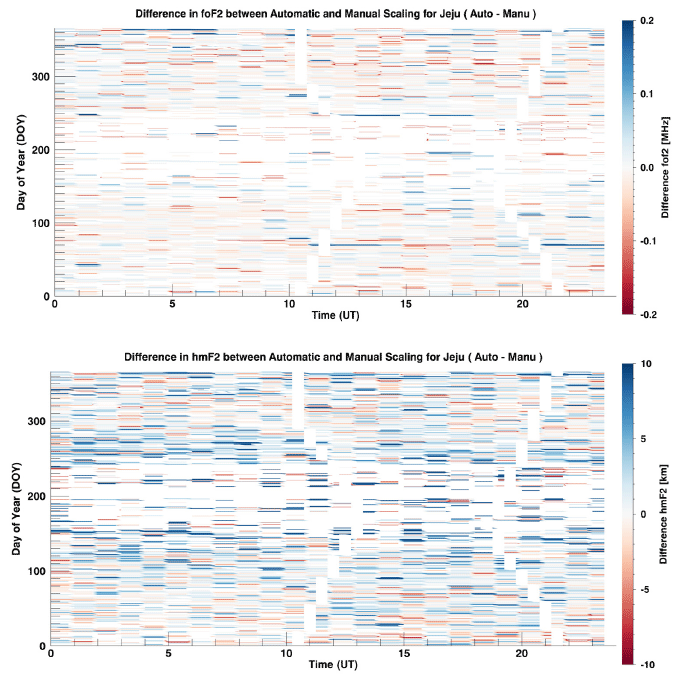
Histograms of the differences in auto-scaled and manually scaled foF2 and hmF2 values are shown in Fig. 8. A total of 25,247 foF2 values are included in the histogram for 35,136 ionograms with the exception of those that cannot be used to extract the parameters. The average foF2 difference value between the auto-scaled and manually scaled methods is 0.03±0.12 MHz. Additionally, 25,195 data points are used on the right side (hmF2). The average difference of hmF2 values is 4.13 km (auto-scaled values are positively biased) and its standard deviation is 9.58 km, and this is significantly high.
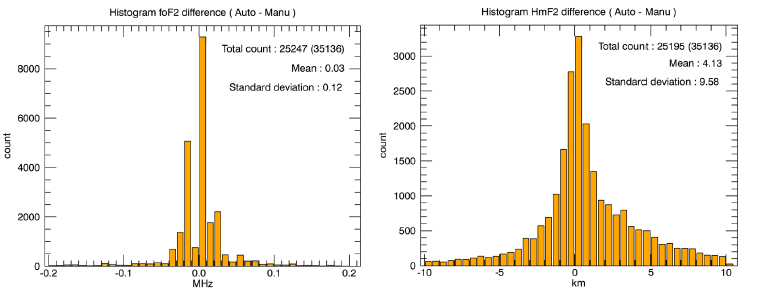
Fig. 9 shows the percentages of the five cases that were designated during the manual scaling process. The results indicate that more than half of the ionograms in August should be manually scaled because the ionograms contained abnormal echoes especially during a period from July 22 to August 27. With respect to the other months, approximately 30–35 % of the ionograms should be manually scaled. In the five cases, we observe that case 1 (errors in determining foF2) and case 4 (errors in distinguishing F1/ F2) occur more frequently when compared with the other cases. We observe that 36 % of the ionograms (9,245) by auto-scaling result in values that differ from those obtained via manual scaling.
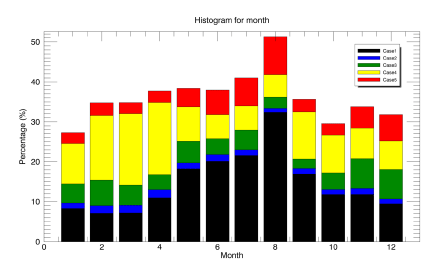
Fig. 10 shows the distributions of auto-scaled foF2s and manually scaled foF2s on the plane of time versus day of year. Evidently, the deficiency of auto-scaling during summer is highlighted by the significantly high number of manual scaling values. Specifically, from a total of 35,136 ionograms recorded in 2012, we manually extracted parameters from 32,065 ionograms, and this exceeds the autoscaled ionograms by 6,384.
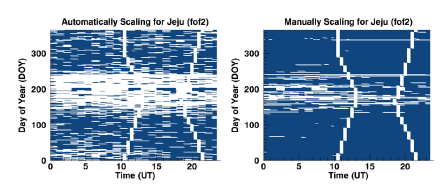
4 CONCLUSION
In this study, we manually scaled 35,136 ionograms recorded by Jeju ionosonde throughout 2012 and compared the resulting foF2 and hmF2 values to those obtained via the auto scaling program, ARTIST 5002. We identified five cases in which the auto-scaling program leads to incorrect results when compared with manual scaling results. The results indicated that 36 % of the auto-scaled parameters in 2012 differed from the manually scaled parameters by the first decimal number. The auto-scaled hmF2 values differ more significantly from manually scaled values when compared with the foF2 values. Hence, future studies should note the uncertainty of auto-scaled parameters, and manually scaled values should be used for any serious applications to the maximum possible extent.










